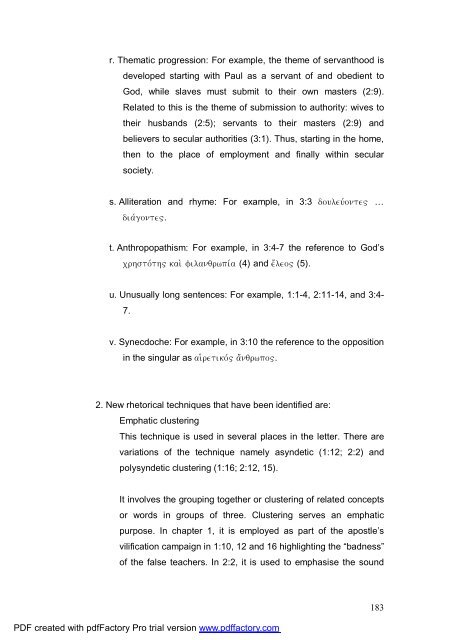A Text centred rhetorical analysis of Paul's Letter to Titus
A Text centred rhetorical analysis of Paul's Letter to Titus
A Text centred rhetorical analysis of Paul's Letter to Titus
Create successful ePaper yourself
Turn your PDF publications into a flip-book with our unique Google optimized e-Paper software.
. Thematic progression: For example, the theme <strong>of</strong> servanthood is<br />
developed starting with Paul as a servant <strong>of</strong> and obedient <strong>to</strong><br />
God, while slaves must submit <strong>to</strong> their own masters (2:9).<br />
Related <strong>to</strong> this is the theme <strong>of</strong> submission <strong>to</strong> authority: wives <strong>to</strong><br />
their husbands (2:5); servants <strong>to</strong> their masters (2:9) and<br />
believers <strong>to</strong> secular authorities (3:1). Thus, starting in the home,<br />
then <strong>to</strong> the place <strong>of</strong> employment and finally within secular<br />
society.<br />
s. Alliteration and rhyme: For example, in 3:3 douleuvonte" …<br />
diavgonte".<br />
t. Anthropopathism: For example, in 3:4-7 the reference <strong>to</strong> God’s<br />
crhs<strong>to</strong>vth" kai; filanqrwpiva (4) and e[leo" (5).<br />
u. Unusually long sentences: For example, 1:1-4, 2:11-14, and 3:4-<br />
7.<br />
v. Synecdoche: For example, in 3:10 the reference <strong>to</strong> the opposition<br />
in the singular as aiJretikov~ a[nqrwpo~.<br />
2. New <strong>rhe<strong>to</strong>rical</strong> techniques that have been identified are:<br />
Emphatic clustering<br />
This technique is used in several places in the letter. There are<br />
variations <strong>of</strong> the technique namely asyndetic (1:12; 2:2) and<br />
polysyndetic clustering (1:16; 2:12, 15).<br />
It involves the grouping <strong>to</strong>gether or clustering <strong>of</strong> related concepts<br />
or words in groups <strong>of</strong> three. Clustering serves an emphatic<br />
purpose. In chapter 1, it is employed as part <strong>of</strong> the apostle’s<br />
vilification campaign in 1:10, 12 and 16 highlighting the “badness”<br />
<strong>of</strong> the false teachers. In 2:2, it is used <strong>to</strong> emphasise the sound<br />
PDF created with pdfFac<strong>to</strong>ry Pro trial version www.pdffac<strong>to</strong>ry.com<br />
183

















